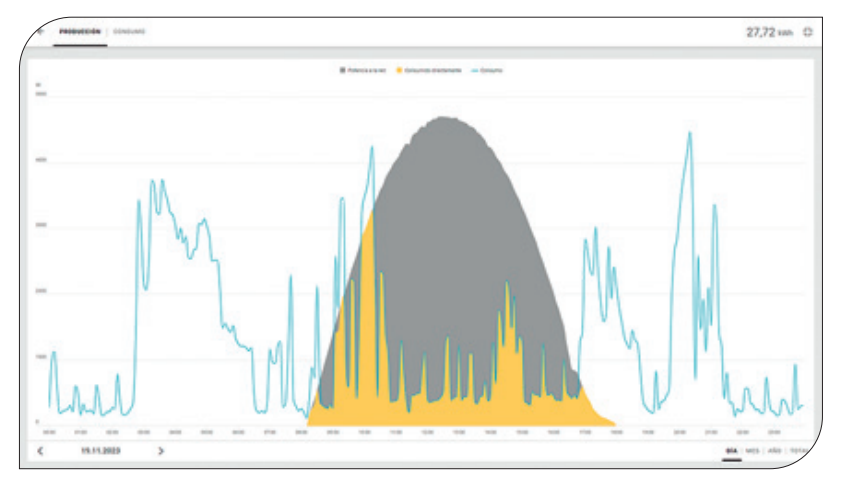When it comes to designing a photovoltaic installation, the focus is on module efficiency, orientation, optimal tilt, and kWh/kWp generation potential… But do we really know how to make the most of the kWh we generate?
In most residential photovoltaic installations, we encounter a problem: the photovoltaic production curve is completely opposite to our consumption curve. Typically, we produce more when we are not at home.
In the example above, we observe how consumption peaks during the early and late hours of the day.

Specifically, on November 19th, this installation required a total of 29.13 kWh, of which 21 kWh were supplied by the grid, and only 8 kWh were provided by our photovoltaic installation. If we analyze in terms of energy produced, we can see that we generated a total of 27.72 kWh.
That is, we generated 95% of the energy our home needed, but only utilized 29%, with the rest— the famous energy surplus— being fed back into the distribution grid.
How do we compensate for our photovoltaic surpluses?
Currently, thanks to Royal Decree 244/2019, surplus compensation is facilitated. This mechanism allows the electricity provider to offset the energy we inject into the grid with the energy we consume, but it’s not a 1:1 relationship.
Moreover, this system has some drawbacks. Firstly, compensation is based on the billing period, so surplus generated in one period cannot be used to offset consumption in another. Additionally, compensation is limited to consumed energy, meaning it will never discount more than what we consume. Finally, this compensation only applies to the variable portion, so we still have to pay the fixed part (contracted power, meter rental, taxes…).
Currently, some suppliers offer so-called virtual batteries, which are essentially a form of virtual wallet. In these cases, the company gradually adds the agreed balance for each kWh we inject into the grid to this wallet. With this balance, we can pay our entire bill, and some suppliers even offer the option to use it to pay bills for other supply points we may have, such as a second residence.
But what alternatives do we have to utilize this production without the need to feed back into the grid? Let’s explore different options.
How can we utilize our surplus without feeding it back into the grid?
Lithium Batteries
The first option that certainly comes to mind is to install a lithium battery to charge during times of surplus and discharge when photovoltaic production is not sufficient to cover all our consumption.
Thanks to Fronius’ monitoring software, if we already have a photovoltaic installation installed and monitored, we can know exactly how our installation will perform if we install a battery, specifically a BYD battery.
In the previous installation, which started last September, we had a self-consumption percentage of 29%. That is, in these months, 29% of our consumption was provided by the photovoltaic installation, while the remaining 71% was supplied by the grid.
Source: Renováveis Magazine




